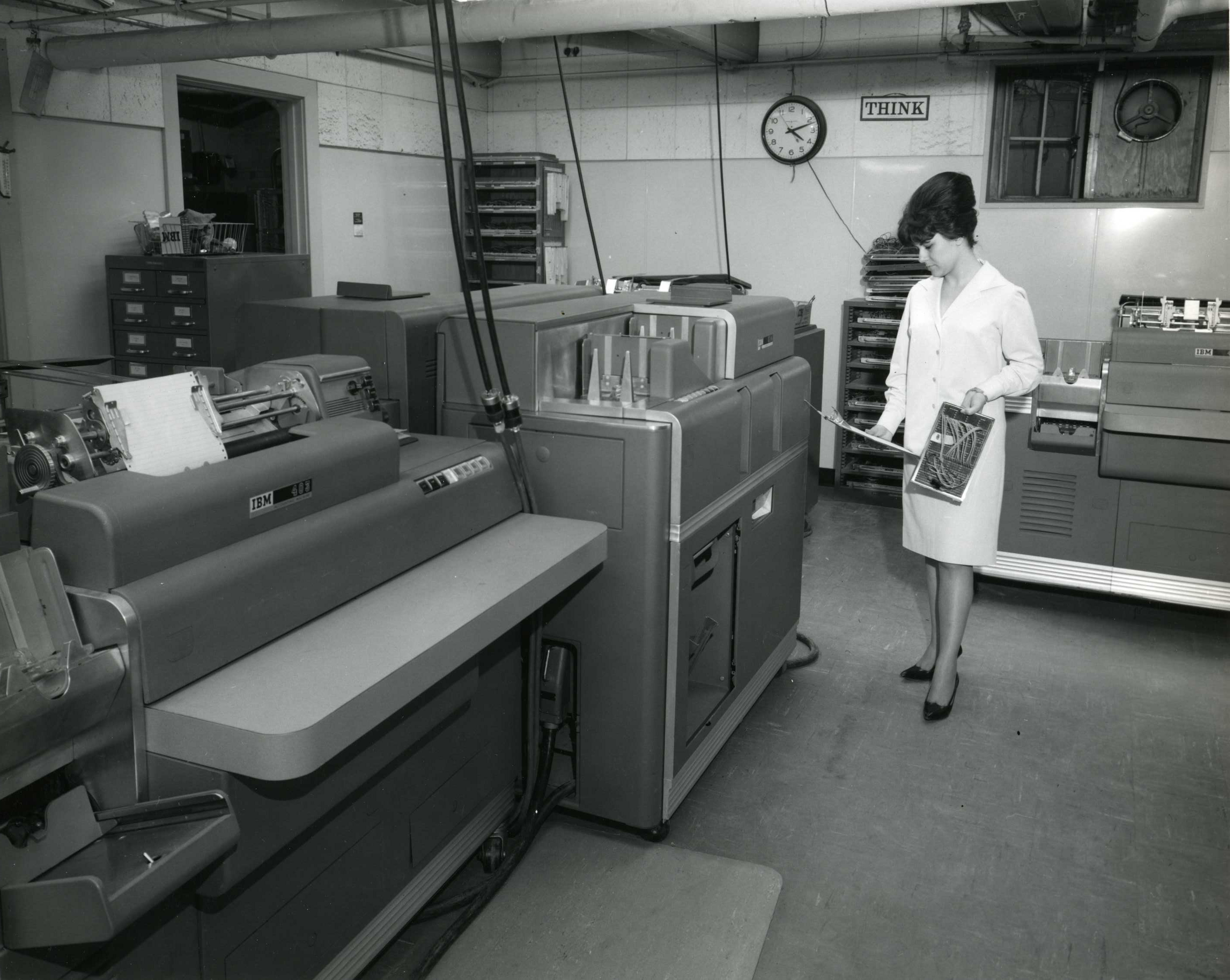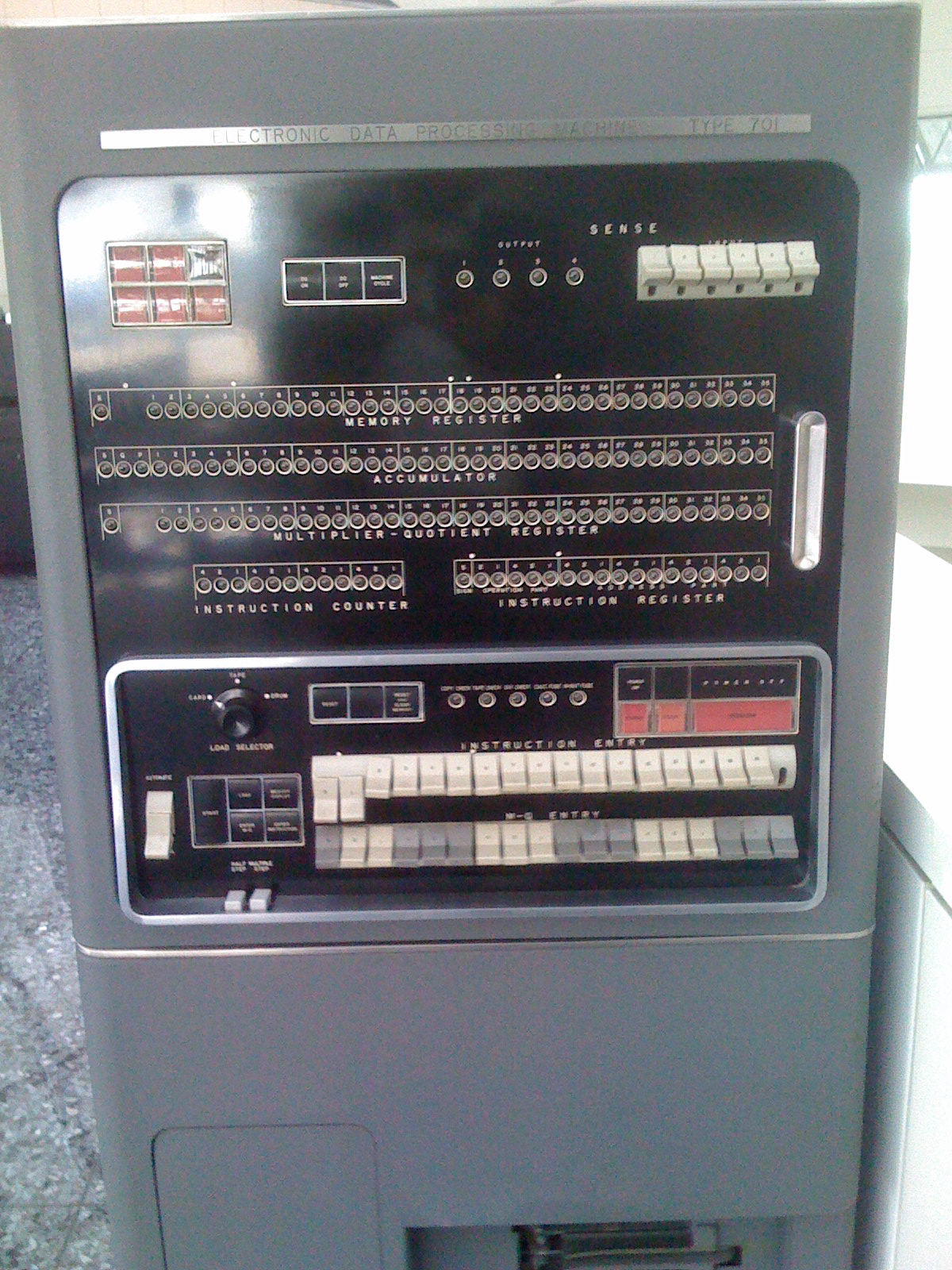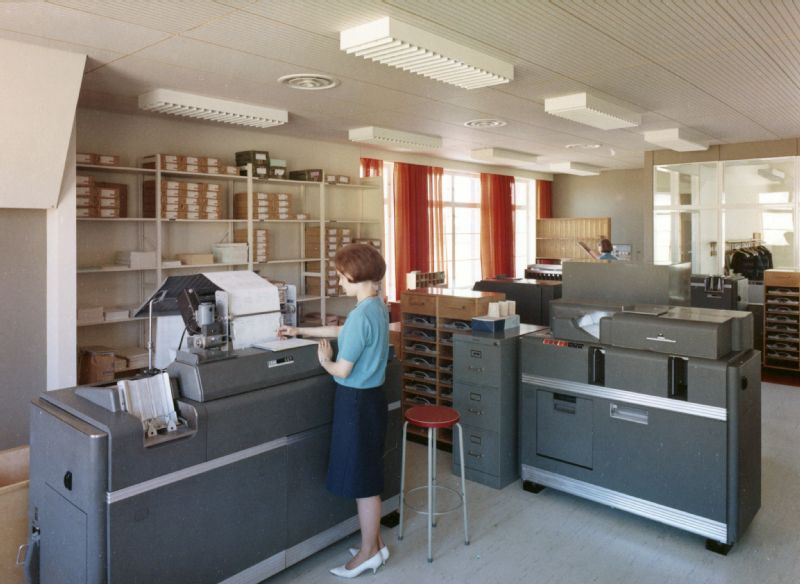|
IBM 1443
The IBM 1443 Printer (sometimes referred to as the ''1443 Flying Type Bar Printer'') is an obsolete computer line printer used in the punched card era. It was offered in three models: Models 1, 2 and N1; the last two could print up to 240 lines per minute (LPM) with a full character set. The 1443 was initially introduced October 11, 1962 for use with the IBM 1440 system and withdrawn February 8, 1971. It was announced in 1963 for the 1620 system. The printer could also be used on the IBM 1620 (announced 1963), IBM 1710, IBM 1800 and System/360. Decades later IBM recycled the 1443 model number to refer to a different product. Technology Beginning in 1920, IBM developed a series of printers * IBM 405 - introduced in 1934 - top speed was 80 lines per minute. * IBM 402 - introduced after World War II - printed as many as 100 lines per minute. These IBM printers, as did others of the early punched card era, use "type bars," originally developed for their line of accounting machi ... [...More Info...] [...Related Items...] OR: [Wikipedia] [Google] [Baidu] |
IBM 1401
The IBM 1401 is a variable-wordlength decimal computer that was announced by IBM on October 5, 1959. The first member of the highly successful IBM 1400 series, it was aimed at replacing unit record equipment for processing data stored on punched cards and at providing peripheral services for larger computers. The 1401 is considered to be the Ford Model-T of the computer industry, because it was mass-produced and because of its sales volume. Over 12,000 units were produced and many were leased or resold after they were replaced with newer technology. The 1401 was withdrawn on February 8, 1971. History The 1401 project evolved from an IBM project named World Wide Accounting Machine (WWAM), which in turn was a reaction to the success of Bull Gamma 3 (fr). The 1401 was operated as an independent system, in conjunction with IBM punched card equipment, or as auxiliary equipment to IBM 700 or 7000 series systems. Monthly rental for 1401 configurations started at US$2,500 (wort ... [...More Info...] [...Related Items...] OR: [Wikipedia] [Google] [Baidu] |
IBM 1403
The IBM 1403 line printer was introduced as part of the IBM 1401 computer in 1959 and had an especially long life in the IBM product line. Description The original model can print 600 lines of text per minute and can skip blank lines at up to 75 inches per second (190 cm/s), while the model 3 can print at up to 1400 lines per minute. The standard model has 120 print positions. An additional 12 positions are available as an option. A print chain with up to 15 copies of the character set spins horizontally in front of the ribbon and paper. Hammers strike the paper from behind at exactly the right moment to print a character as it goes by. In later models, the print chain is replaced by a print train; print slugs instead of being mounted on a chain are placed in a track. The 1403 chain or train contains 240 characters, however numerous duplications allow a line to be printed in less than the 0.4 s required for one full rotation. The original standard "A" chain c ... [...More Info...] [...Related Items...] OR: [Wikipedia] [Google] [Baidu] |
Line Printer
A line printer prints one entire line of text before advancing to another line. Most early line printers were impact printers. Line printers are mostly associated with unit record equipment and the early days of digital computing, but the technology is still in use. Print speeds of 600 lines per minute (approximately 10 pages per minute) were achieved in the 1950s, later increasing to as much as 1200 lpm. Line printers print a complete line at a time and have speeds in the range of 150 to 2500 lines per minute. The types of line printers are drum printers, band-printers, and chain printers. Other non-impact technologies have also been used, as thermal line printers were popular in the 1970s and 1980s, and some inkjet and laser printers produce output a line or a page at a time. Designs Many impact printers, such as the daisywheel printer and dot matrix printer, used a print head that printed a character then moved on until an entire line was printed. Line printers ... [...More Info...] [...Related Items...] OR: [Wikipedia] [Google] [Baidu] |
IBM 700/7000 Series
The IBM 700/7000 series is a series of large-scale (mainframe) computer systems that were made by IBM through the 1950s and early 1960s. The series includes several different, incompatible processor architectures. The 700s use vacuum-tube logic and were made obsolete by the introduction of the transistorized 7000s. The 7000s, in turn, were eventually replaced with System/360, which was announced in 1964. However the 360/65, the first 360 powerful enough to replace 7000s, did not become available until November 1965. Early problems with OS/360 and the high cost of converting software kept many 7000s in service for years afterward. Architectures The IBM 700/7000 series has six completely different ways of storing data and instructions: *First scientific (36/18-bit words): 701 (Defense Calculator) *Later scientific (36-bit words, hardware floating-point): 704, 709, 7040, 7044, 7090, 7094 *Commercial (variable-length character strings): 702, 705, 7080 * 1400 series (variab ... [...More Info...] [...Related Items...] OR: [Wikipedia] [Google] [Baidu] |
IBM 701
The IBM 701 Electronic Data Processing Machine, known as the Defense Calculator while in development, was IBM’s first commercial scientific computer and its first series production mainframe computer, which was announced to the public on May 21, 1952. It was invented and developed by Jerrier Haddad and Nathaniel Rochester based on the IAS machine at Princeton. The IBM 701 was the first computer in the IBM 700/7000 series, which were IBM’s high-end computers until the arrival of the IBM System/360 in 1964. The business-oriented sibling of the 701 was the IBM 702 and a lower-cost general-purpose sibling was the IBM 650, which gained fame as the first mass-produced computer in the world. History IBM 701 competed with Remington Rand's UNIVAC 1103 in the scientific computation market, which had been developed for the NSA, so it was held secret until permission to market it was obtained in 1951. In early 1954, a committee of the Joint Chiefs of Staff requested that the ... [...More Info...] [...Related Items...] OR: [Wikipedia] [Google] [Baidu] |
IBM 716
The IBM 716 line printer was used with IBM 700/7000 series computers in the 1950s and 1960s. It was introduced on May 21, 1952 with the IBM 701 The IBM 701 Electronic Data Processing Machine, known as the Defense Calculator while in development, was IBM’s first commercial scientific computer and its first series production mainframe computer, which was announced to the public on May ... and withdrawn from marketing on July 14, 1969. Overview The 716 was based on IBM 407 accounting machine technology and had 120 rotary type wheels, each with 48 possible characters. It could print 150 lines per minute. It also supplied power to the IBM 711 card reader and 721 card punch. Only 72 characters could be transferred from IBM 7090 computer to the 716 in a single operation, but a full line could be printed at half speed. Characters were printed by sending bit patterns that corresponded to the impulses that a 407 would see when reading a punched card. [...More Info...] [...Related Items...] OR: [Wikipedia] [Google] [Baidu] |
IBM 650
The IBM 650 Magnetic Drum Data-Processing Machine is an early digital computer produced by IBM in the mid-1950s. It was the first mass produced computer in the world. Almost 2,000 systems were produced, the last in 1962, and it was the first computer to make a meaningful profit. The first one was installed in late 1954 and it was the most-popular computer of the 1950s. The 650 was marketed to business, scientific and engineering users as a general-purpose version of the IBM 701 and IBM 702 computers which were for scientific and business purposes respectively. It was also marketed to users of punched card machines who were upgrading from calculating punches, such as the IBM 604, to computers. Because of its relatively low cost and ease of programming, the 650 was used to pioneer a wide variety of applications, from modeling submarine crew performance to teaching high school and college students computer programming. The IBM 650 became highly popular in universities, wher ... [...More Info...] [...Related Items...] OR: [Wikipedia] [Google] [Baidu] |
IBM 407
The IBM 407 Accounting Machine, introduced in 1949, was one of a long line of IBM tabulating machines dating back to the days of Herman Hollerith. It had a card reader and printer; a summary punch could be attached. Processing was directed by a control panel. The 407 was the central component of many unit record equipment shops which were the mainstay of IBM's business at the time. It could print digits, letters and several special characters in any of 120 print positions, spaced . In 1976 the IBM 407 Accounting Machine was withdrawn from marketing. Description The 407 read punched cards, totaled fields on the cards, made simple decisions, printed results, and, with the aid of a summary punch, output results on punched cards that could be input to other processing steps. The operation of the 407 was directed by the use of a removable control panel and a carriage tape. Exit hubs (impulse emitting) on the control panel are wired to entry hubs (impulse accepting) for the ... [...More Info...] [...Related Items...] OR: [Wikipedia] [Google] [Baidu] |
Carriage Control Tape
A carriage control tape was a loop of punched tape that was used to synchronize rapid vertical page movement in most IBM and many other line printers from unit record days through the 1980's. The tape loop was as long as the length of a single page. A pin wheel moved the tape accurately using holes in the center of the tape. A hole punched in one of the other channels represented a particular position on the page. Channel one was typically used to indicate the top of the page and might be the only channel used. Another channel might indicate the summary line on an invoice, enabling rapid skipping to that line. IBM provides a special manual punch that allowed accurate placement of the channel punches. Skipping occurred under computer control, but a form feed switch on the printer control panel allowed a manual skip to the top of the page. The tapes could be easily changed when new, continuously fed forms were loaded into the printer. Forms control buffer Newer printers use a "form ... [...More Info...] [...Related Items...] OR: [Wikipedia] [Google] [Baidu] |
Continuous Stationery
Continuous stationery (UK) or continuous form paper (US) is paper which is designed for use with dot-matrix and line printers with appropriate paper-feed mechanisms. Other names include ''fan-fold paper'', ''sprocket-feed paper'', ''burst paper'', ''lineflow'' (New Zealand), ''tractor-feed paper'', and ''pin-feed paper''. It can be single-ply (usually woodfree uncoated paper) or multi-ply (either with carbon paper between the paper layers, or multiple layers of carbonless copy paper), often described as multipart stationery or forms. Continuous stationery is often used when the final print medium is less critical in terms of the appearance at the edges, and when continuously connected individual sheets are not inconvenient for the application. Individual sheets can be separated at the perforation (leaving a slight serration), and sheets also have edges with punched holes, which also can be removed at the perforation (one typical format). Shape and form Most continuous form pa ... [...More Info...] [...Related Items...] OR: [Wikipedia] [Google] [Baidu] |
IBM 1132
The IBM 1132 line printer was the normal printer for the IBM 1130 computer system. It printed 120 character lines at 80 lines per minute. The character set consisted of numbers, upper-case letters and some special characters. The 1965-introduced 1132 was built around a stripped down IBM 407 printing mechanism. The 407 was IBM's top-of-the-line accounting machine from the 1950s. The 1130 had 120 power transistors, each wired to the print magnet for one printer column. The magnet released a lever that engaged a cam with a spinning clutch shaft. The engaged cam then made one revolution, pushing its print wheel toward the ribbon and paper, thereby printing one character. As the set of 120 print wheels spun, the 1130 received an interrupt as each of the possible 48 characters was about to move into position. The printing driver software had to quickly output a 120 bit vector designating which transistors were to fire so as to drive the print wheel against the ribbon and paper. This p ... [...More Info...] [...Related Items...] OR: [Wikipedia] [Google] [Baidu] |
Typewriter
A typewriter is a mechanical or electromechanical machine for typing characters. Typically, a typewriter has an array of keys, and each one causes a different single character to be produced on paper by striking an inked ribbon selectively against the paper with a type element. At the end of the nineteenth century, the term 'typewriter' was also applied to a ''person'' who used such a device. The first commercial typewriters were introduced in 1874, but did not become common in offices until after the mid-1880s. The typewriter quickly became an indispensable tool for practically all writing other than personal handwritten correspondence. It was widely used by professional writers, in offices, business correspondence in private homes, and by students preparing written assignments. Typewriters were a standard fixture in most offices up to the 1980s. Thereafter, they began to be largely supplanted by personal computers running word processing software. Nevertheless, type ... [...More Info...] [...Related Items...] OR: [Wikipedia] [Google] [Baidu] |









.jpg)
